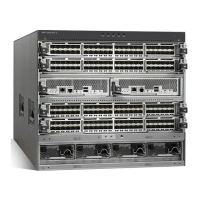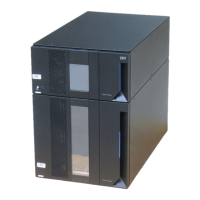LED Status Description
Blue, blinking The operator has activated this
LED to identify this module in the
chassis.
ID
Off This module is not being
identified.
Table 11. Power Supply LEDs (continued)
Power Modes
A c-type SAN Director has a flexible power system.
Any operational power supply provides power to the system power bus. This allows the power load of the
system to be shared equally across all operational power supplies.
Power supply output can be allocated to one of two pools. The available pool is available to bring up
system components. The reserve pool is kept in reserve and not counted towards the available power.
The system can be configured in one of several modes which vary the size of the available and reserve
power pools, according to user requirements.
Combined mode
This mode allocates the output power of all power supplies to available power for switch operations. This
mode does not reserve any output power in case of power outages or power supply failures.
Power supply redundancy mode (N+1)
In this mode one power supply's output is allocated to the reserve power pool. This provides the system
with enough reserve power in case a single power supply fails. The remaining power supplies are
allocated to the available power pool. The reserve power supply must be at least as powerful as the
most powerful power supply in the available pool to potentially replace the full power output of the
failed power supply in the worst case. Because it is impossible to predict which power supply may fail,
we recommend provisioning the system with power supplies of equal rating. This way the output of any
power supply that fails can be replaced by the remaining power supplies.
For example, a system with four 3 kW power supplies in N+1 redundancy mode has a total of 12 kW. 9 kW
are allocated to the available power pool and 3 kW are reserved. If any of the power supplies fail enough
power is reserved that the remaining power supplies can still meet the 9 kW commitment.
Input grid redundancy mode (grid redundancy)
In this mode half of the power supply's output is allocated to the reserve power pool and half to the
available power pool. This provides the system with enough reserve power in the case of 50% of the
power supplies failing, as when a power grid fails. The system logically allocates the left two columns
of PSU bays to Grid A and sums the output power of operational PSUs. It does the same for the right
two columns (Grid B) and uses the minimum of the two as the available power pool. To utilize maximum
power the sum of power supply outputs of Grid A and Grid B PSU bays must be equal.
For example, a system with four 3 kW PSUs in Grid A bays and three 3 kW PSUs in Grid B bays and in grid
redundancy mode has 12 kW available from Grid A and 9 kW from Grid B. The minimum of the two grids
is 9 kW so 9 kW is allocated to the available power pool and 9 kW are reserved. If either grid fails enough
power is reserved that the remaining power supplies can still meet the 9 kW commitment. The output of
the fourth PSU in Grid A is not considered in the calculations even though it provides power.
Chapter 1. Introducing the IBM c-type SAN Directors41

